Dental Implants – Altavista, VA
Modern Solutions
for Tooth Loss
The loss of your permanent teeth can be a devastating experience, not only for your oral health but for your self-esteem and overall quality of life as well. At Miller & Wolf Family Dentistry, our doctors and team members want to work with you as soon as possible to restore your smile to its former glory – and there’s no better option today than dental implants! Please contact us today to schedule your first appointment, or if you have any questions about modern, transformative dental implants in Altavista, VA.

Why Choose Miller & Wolf Family Dentistry
for Dental Implants?
- Partnered with Local Specialists for the Best Results
- Permanently Replace Any Number of Missing Teeth
- Insurance Accepted & Flexible Financing Options Available
What are Dental Implants?
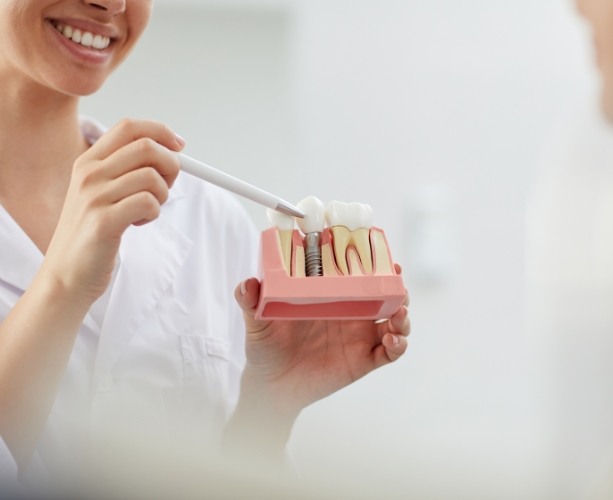
Natural teeth are composed of two parts: the shiny white crowns you see when you smile and the hidden roots underneath the gums. Traditional tooth replacement services like bridges and dentures only replace the crowns of missing teeth. While these options are better than nothing, they tend to leave a lot to be desired in terms of longevity, comfort, and functionality. In contrast, dental implants recreate the entire structure of a missing tooth or teeth from crown to roots.
A dental implant is a small titanium post that can be inserted into the jawbone to replace the missing roots. Because this helps to stimulate the jawbone, choosing dental implants is ultimately better for your health and oral function over time! On top of the implant is a custom-made restoration that blends in seamlessly with your remaining teeth. Depending on your unique situation, this could be a crown, bridge, or denture. In the end, you get a smile that looks, feels, and functions just like natural!
The 4-Step Dental
Implant Process
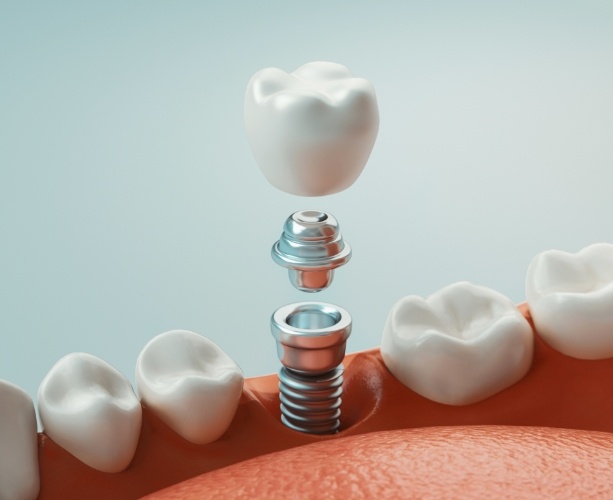
- The Initial Consultation. During the initial consultation, our team will examine your mouth, take X-rays, speak with you about your medical history, and listen to any goals or specific needs you’d like to have met with dental implants. Based on all of this, we’ll be able to create a custom-tailored treatment plan for you.
- Dental Implant Placement. We typically refer patients out to a local specialist for dental implant placement to achieve the best possible results.
- Osseointegration & Abutment Placement. Once your implants have been placed, they’ll fuse with the jawbone through a process called osseointegration. Once that’s complete, you’ll come back in so we can attach small, metal connector pieces called abutments to your implant posts.
- Securing the Final Restoration. After we receive your final restoration from our dental laboratory, we’ll call you back in to secure it to your abutments.
Benefits of
Dental Implants

- Easy maintenance: Caring for dental implants is as easy as practicing great oral hygiene! Just remember to brush, floss, and visit us for regular checkups.
- A permanent solution: Other tooth replacement options need to be replaced every five to ten years. Dental implants, on the other hand, can easily last 30 years. In fact, most patients can expect to enjoy their dental implants for a lifetime with the proper care!
- Truly lifelike results: Dental implants are practically indistinguishable from natural teeth in every way. You’ll be able to eat all your favorite foods and talk without worry. It’s extremely unlikely that anyone will be able to tell your dental implant(s) apart from the rest of your pearly whites. What’s more, dental implants are so comfortable and reliable, you may even forget that they’re there!
Who Dental
Implants Can Help
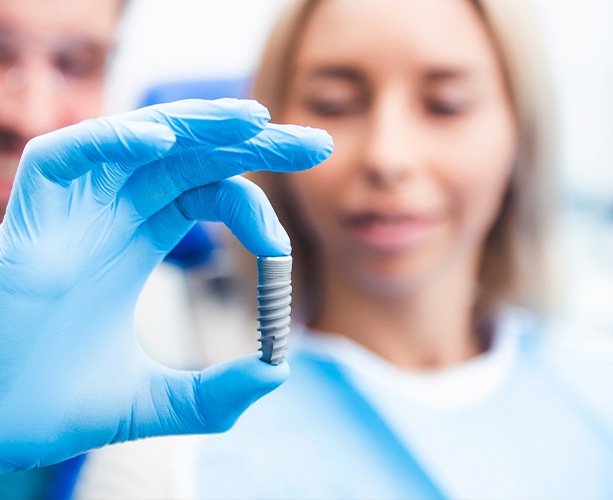
Dental implants can be used to support a number of custom restorations depending on how many teeth you’re missing. We offer several restoration options, including crowns, bridges, and implant dentures. Our doctors will be happy to help you determine which option is right for your unique smile needs.
Missing Single Tooth
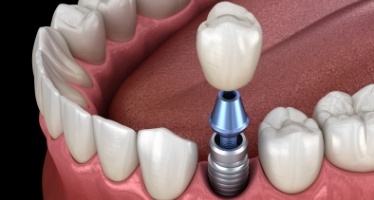
For a single missing tooth, we can place one dental implant below the gumline that will secure a customized dental crown in the gap, restoring your complete arch of teeth.
Missing Multiple Teeth
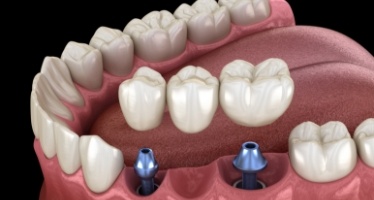
Instead of needing to alter your existing teeth by placing a traditional bridge, we can secure one to two dental implants that we place at either end of the gap in your smile.
Missing All of Your Teeth
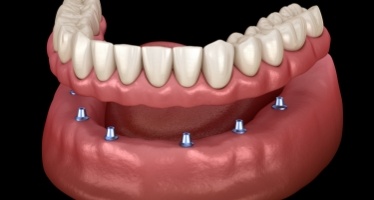
We can anchor a denture to anywhere from four to eight dental implants that we strategically place along your arch to eliminate any slipping or shifting.
Understanding the Cost
of Dental Implants

The dental implant procedure is custom-tailored to fit each patient’s unique needs, so there’s no singular price tag attached to it. If you’d like to learn how much it would cost for you to get dental implants, come in for a consultation so we can outline some important cost-determining factors, like how many implants you’ll need to have placed and what type of restoration you require. Then, we can walk you through financing options and insurance coverage details.
Dental Implant FAQs
Does Getting Dental Implants Hurt?
No, you should not expect to feel any pain while getting your dental implants placed. Firstly, your oral surgeon will numb the area of your mouth that they will be working on with a local anesthetic before starting the process, that way you’re completely pain-free during your appointment. You will also likely be provided with sedation dentistry to help you remain calm and relaxed while also reducing your body’s ability to register pain. Furthermore, the jawbone doesn’t contain many nerve endings. Though the procedure itself shouldn’t hurt, you’ll normally experience some soreness for several days following your treatment. Use a cold compress to alleviate swelling and take OTC/prescribed pain relievers to minimize discomfort. If you notice any worsening symptoms after two or three days, give our team a call for help.
How Successful Are Dental Implants?
If placed by an experienced professional, you can expect your dental implants to have a success rate of 95% or more even after a decade. Of course, this will depend on certain factors that help ensure the life of your new pearly whites, such as how well you take care of them through daily oral hygiene, a healthy diet, and regular dental checkups every six months. Even the location of the dental implant in the mouth can affect the success rate. For instance, molars tend to experience more strain from excessive chewing compared to front teeth, meaning they can be more susceptible to failure without proper precautions. Our team will provide you with aftercare instructions so that you know the best ways to make the most of your treatment results.
What Should I Do If My Implant Feels Loose?
The common indications of a failed dental implant include moderate to severe pain surrounding the implant, swelling or inflammation in the gums, or a feeling that the implant is loose. You might even feel a difference in your bite or discomfort when chewing. If you suspect your new tooth is loose (or any of the other symptoms), notify our team right away so we can address the issue and salvage your implant. Even if it’s only been a week after placement or years later, your dentist might be able to help keep your results from failing. The sooner you can get treatment, the better the chances of preserving your implant(s).
How Long Does It Take to Recover from Dental Implant Surgery?
The majority of the time, patients can resume their daily activities 24 hours following their surgery. Of course, you’ll want to avoid excessive physical activity, as the implant will need time to heal and properly fuse with your jawbone. This portion of the healing process can take anywhere from three to six months depending on your oral health and how well you adhere to your aftercare guidelines. In most cases, you might expect some bleeding after the first couple of days and swelling should fade after a few days. While you can’t speed up your recovery, you can help it go smoothly by using a cold compress and taking prescribed/OTC pain medications to minimize discomfort. If there are pain issues, notify our team immediately for help.
